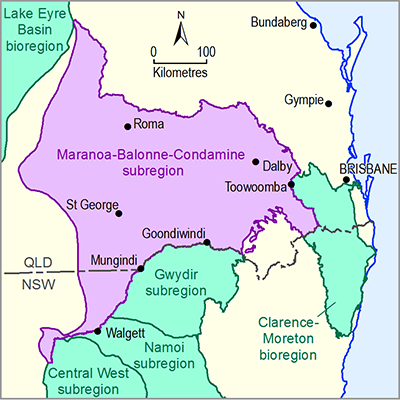Additional drawdown in the regional watertable, with a greater than 5% chance of exceeding 0.2 m, covers an area of 1631 km2 (Figure 13). Subsequently, the extent in the zone of potential hydrological change is reported as 1544 km2, which excludes the 87 km2 within the modelled open-cut mine pits that are not included in the analysis. The zone of potential hydrological change in the regional watertable contains 1544 km2 of vegetation and 1095 km of stream network.
The modelled open-cut mine pits (Figure 13) were not included in the analysis for the following reasons:
- modelled drawdowns within the modelled pits are highly uncertain due to the very steep hydraulic gradients at the mine pit interface
- changes in the drawdown are inevitable where the mine pit intersects the regional watertable
- other factors, such as physical removal of a wetland or creek, may have a larger impact on a landscape class than the predicted decrease in groundwater level
- impacts are predominantly site-scale, assumed to be adequately addressed through existing development approval processes, and hence not the primary focus of BAs.
Note that there is no exclusion zone identified for CSG wells or infrastructure associated with CSG development.
In the impacts on landscape classes and assets sections (Section 3. 4 and Section 3 .5, respectively), the initial assessment summarises what is in the zone of potential hydrological change and, within that, what is in the mine pit exclusion zone. Areas were differentiated by attribute class (e.g. bore purpose; hydrological response variable class) for areas in the zone of potential hydrological change, but no differentiation by attribute class was undertaken for features in the modelled open-cut mine pits.

Product Finalisation date
- 3.1 Overview
- 3.2 Methods
- 3.3 Potential hydrological changes
- 3.4 Impacts on and risks to landscape classes
- 3.4.1 Overview
- 3.4.2 Landscape classes that are unlikely to be impacted
- 3.4.3 'Floodplain or lowland riverine (including non-GAB GDEs)' landscape group
- 3.4.4 'GAB GDEs (riverine, springs, floodplain or non-floodplain)' landscape group
- 3.4.5 'Non-floodplain or upland riverine (including non-GAB GDEs)' landscape group
- 3.4.6 'Human-modified' landscape group
- References
- Datasets
- 3.5 Impacts on and risks to water-dependent assets
- 3.6 Commentary for coal resource developments that are not modelled
- 3.7 Conclusion
- Citation
- Acknowledgements
- Contributors to the Technical Programme
- About this technical product
